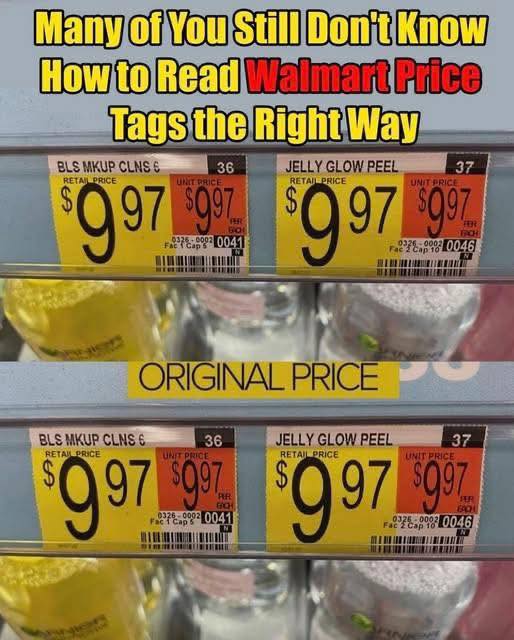How to Decode Walmart Price Tags Like a Pro—and Save More Every Trip

If you’re a regular Walmart shopper like me, you know the thrill of spotting a deal—but did you know that Walmart price tags actually hold secret clues about how good a deal really is? Once you learn how to read them the right way, you’ll shop smarter, save more, and maybe even beat the markdown clock.
Let’s start with the basics: those tiny numbers and symbols at the end of a price aren’t random—they often mean something about the item’s pricing status.
📌 Prices Ending in “.00” or “.88”:
These are standard prices—either the original price set by Walmart or the item’s Everyday Low Price. Nothing special here, but they serve as your baseline.
🔍 Prices Ending in “.97”:
A lot of shoppers assume “.97” means clearance, and in many cases, they’re right. Items marked with this pricing are often being phased out or are part of a markdown cycle. But here’s the catch: just because it’s on clearance doesn’t mean it’s the lowest price it will reach. Clearance items often continue to drop in price until they sell out or reach their final markdown.
🧩 Prices Ending in “.01” or “.1”:
Now this is where it gets interesting. Items with prices ending in “.01” or “.1” are often believed to be at their absolute lowest. While that’s mostly true, it’s not a guarantee. These prices typically show up after several markdowns—but there may still be another drop before they disappear completely. So if you’re eyeing something at this price, weigh your risk: grab it now or wait for another markdown (if it’s still there!).
📅 Check the Date on the Price Tag:
One of the most overlooked clues is the small printed date on the tag—this tells you when the item was last marked down. Most items sit at a marked down price for about 30 days before getting reduced again. So if it’s been on the shelf a few weeks and hasn’t moved, you might want to wait it out—unless it’s popular!
🔴 The Magic of the Rollback Tag:
Spot a red “Rollback” tag? That’s Walmart’s temporary price drop—essentially a mini-sale. Rollbacks can happen for a few reasons: maybe the supplier cut prices, or Walmart ordered too much of something. Either way, you’re getting a deal—but here’s the key: rollbacks are limited-time offers, usually lasting just a few weeks. If you see something on rollback that you need or love, don’t wait too long!
🎯 Walmart’s Pricing Strategy at Work:
Behind the scenes, Walmart works directly with suppliers to negotiate discounts, and when they end up with extra stock, they use rollbacks and markdowns to keep things moving—and to keep shoppers happy. It’s part of a larger strategy to maintain their reputation for low prices and fast turnover.
Pro Tips to Level Up Your Walmart Shopping Game:
- Track the tag dates. Use your phone to snap a photo and check back later to see if the price dropped.
- Look high and low. Clearance and final markdowns are often placed on higher or lower shelves—not eye level.
- Know your numbers. A “.97” is good, a “.01” might be better, and a red rollback tag means now or never.
- Don’t assume online prices match in-store. Always scan the item using the Walmart app—you might find an even better deal digitally!
Understanding Walmart’s pricing codes isn’t just fun—it can genuinely stretch your budget. With just a little extra attention to the numbers, dates, and tags, you’ll start to notice patterns that help you decide when to buy and when to wait.
So next time you’re cruising through the aisles, keep your eyes peeled for those hidden hints. Because sometimes, the best savings aren’t in the sales section—they’re right on the price tag.
Would you like a printable cheat sheet of Walmart’s price codes to take with you on your next shopping trip?